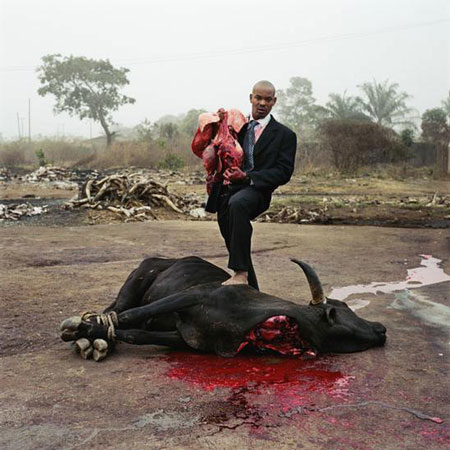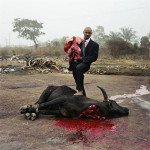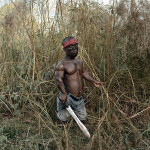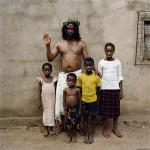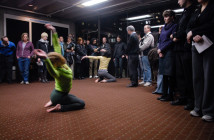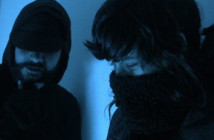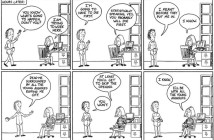I am not sure how to best treat a bloodstain. Is it cold water? Tide? Or must the ruined article of clothing be thrown away? These are the thoughts that ran through my mind while viewing a man gut a bull, ruining his white dress shirt in the process. This oddly grotesque image is one of the many striking staged photographs in Nollywood, a Pieter Hugo exhibition at Yossi Milo gallery in New York.
Entering the gallery I was met with a cold stare from a machete-wielding little person. His gaze locked with mine and set the tone for the rest of the show. The larger than life scale adds to the cinematic context of the work but upon closer examination the artist moves past the creation of a “film still.” The color is a bit de-saturated so as not to artificially heighten the absurdity, and the focus on the work moves from the film aspect to the cultural aspect. In our society we are told not to stare “don’t stare, it’s not polite” but in a gallery setting, in a white cube, the 30x40 black framed images invite the viewer to stare. So I do. Presented in this setting it is required.
As a white South African Hugo attempts to view this industry not as an outsider but as a fellow art maker. Rather than tagging along with the film crew, he emulates their process, taking to the streets with minimal budget, a former actor, and an assistant or two from the industry.
Despite working in similar locations and continuing his exploration of performing subjects and the gaze, I would not categorize this work with Hugo’s other well-known work The Hyena and Other Men as portraiture. Nollywood does not suggest a glimpse into the lives of actors nor does it give the viewer any sense of reality. While it does not offer us a glimpse of a person it does offer a glimpse of society. Secondary to Bollywood culture and tertiary to Hollywood, what the Nollywood images do show us what is sought after for entertainment. Nollywood does not have “actors” in the traditional sense; it is a straight-to-video low budget approach to movie making shot over the course of a week on location in the streets of Nigeria. The actors are volunteers, pulled off the streets to stand in for a scene. The lines are shouted, not spoken with any subtlety, and the gestures are often so over dramatic as to mimic the silent film era.
At first the vast difference in actor’s quality and skill between the Hollywood we know and the Nollywood we are being shown make the two industries appear to be disparate. Perhaps the two industries are more alike than not. Hugo presents his viewers with an absurd scenario in an ordinary setting. Is this so unlike the crime shows dominating our prime time? Is gutting a bull in the street wearing a suit so different from performing an autopsy in a prom dress? It is refreshing to see a body of work that while possessing a dark humor, possesses humor nonetheless. The layers that Hugo compels his viewers to dig though both aesthetically and culturally make Nollywood a refreshing intellectually clever show worth seeing. Exiting the gallery, the machete-wielding man’s eyes on my back I ask the question do the real differences regarding our entertainment standards lie in the production value?
- Pieter Hugo, Gabazzini Zuo. Enugu, Nigeria, digital chromogenic print, 2008
- Pieter Hugo, Omo Omeonu, Enugu, Nigeria, digital chromogenic print, 2008
- Pieter Hugo, Malachy Udegbunam with children. Enugu, Nigeria, digital chromogenic print, 2008
"Pieter Hugo: Nollywood" is on view until April 10, 2010 at Yossi Milo Gallery, located at 525 West 25th St., New York.
All images are courtesy of the artist and Yossi Milo Gallery.

